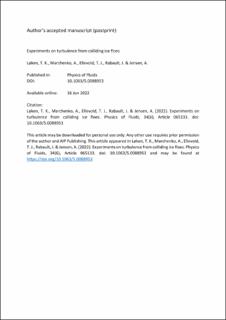Experiments on turbulence from colliding ice floes
Peer reviewed, Journal article
Accepted version

Åpne
Permanent lenke
https://hdl.handle.net/11250/3053533Utgivelsesdato
2022Metadata
Vis full innførselSamlinger
Originalversjon
Løken, T. K., Marchenko, A., Ellevold, T. J., Rabault, J. & Jensen, A. (2022). Experiments on turbulence from colliding ice floes. Physics of Fluids, 34(6), Article 065133. doi: 10.1063/5.0088953Sammendrag
Increased knowledge about energy dissipation processes around colliding ice floes is important for improved understanding of atmosphere-ice-ocean energy transfer, wave propagation through sea ice, and the polar climates. The aim of this study is to obtain such information by investigating colliding ice floe dynamics in a large-scale experiment and directly measuring and quantifying the turbulent kinetic energy (TKE). The field work was carried out at Van Mijen Fjord on Svalbard, where a 3x4 m ice floe was sawed out in the fast ice. Ice floe collisions and relative water–ice motion were generated by pulling the ice floe back and forth in an oscillatory manner in a 4x6 m pool, using two electrical winches. Ice floe motion was measured with a range meter and accelerometers, and the water turbulence was measured acoustically with Doppler velocimeters and optically with a remotely operated vehicle and bubbles as tracers. Turbulent kinetic energy spectra were found to contain an inertial subrange where energy was cascading at a rate proportional to the -5/3 power law. The TKE dissipation rate was found to decrease exponentially with depth. The total TKE dissipation rate was estimated by assuming that turbulence was induced over an area corresponding to the surface of the floe. The results suggest that approximately 37% and 8% of the input power from the winches were dissipated in turbulence and absorbed in the collisions, respectively, which experimentally confirms that energy dissipation by induced turbulent water motion is an important mechanism for colliding ice floe fields.